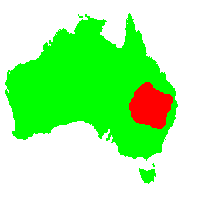General Description:
Dodonaea is predominantly an Australian genus which is well distributed in all states. There are 69 species and 60 of them are endemic to Australia. They are commonly called ‘hop bushes’ because the colourful fruits resemble the fruits used in brewing.
Dodonaea sinuolata is a small to medium shrub to 1-3 metres in height with an erect or spreading habit. The leaves are pinnate to about 30 mm long with up to 22 linear-shaped leaflets. Male and female flowers are borne on separate plants but as with most dodonaeas they are visually insignificant. The fruits occur in summer and autumn and are reddish brown, winged capsules about 10 mm in diameter. These only occur on female plants.
Two subspecies are recognised, subsp. sinuolata and subsp. acrodentata. The latter has broader leaves that are lobed at the apex.
D.sinuolata is reasonably popular in cultivation as it is has both colourful fruits and attractive foliage. It requires a well drained position in full sun or dappled shade. It will tolerate at least moderate frosts. Pruning during fruiting for indoor decoration helps to maintain a bushy shape.
Propagation can be carried out from seed following pretreatment in near boiling water. However, for horticultural purposes, propagation from cuttings is the preferred method as this ensures that female plants (with the attractive fruits) are propagated. For further information on propagation, see Dodonaea – THe Hop Bush, in Issue 27 of Australian Plants online.

Dodonaea sinuolata
Photo: Murray Fagg – Australian National Botanic Gardens
 Australian Native Plants Society (Australia)
Australian Native Plants Society (Australia)